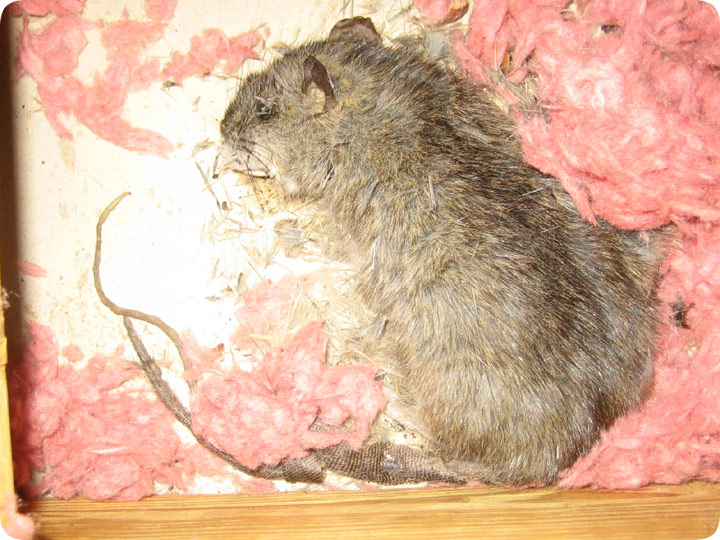-
info@aaanimalcontrol.com
Call us for help in your town
Humane Wildlife Education
Dead Rat In the Attic - Remove Dead Rodent in Attic

05.03.2007 - This is a fairly common job: the dead rat in the attic. Rats are probably the most common animal to invade human dwellings (aside from humans, that is), and they have short life spans and often live in high numbers and are persecuted with poisons and so on and so forth, and so they die inside buildings quite often. Since they tend to live in attics, they also tend to die in attics. Thus, the most common dead animal removal job I have is the dead rat in the attic.
I don't always know if it's a dead rat when I'm called to the scene, but once inside the building, I can definitely smell a rat. Rats tend to have a more foul-flavored stench than other dead animals, but because of their smaller size, it's a weaker overall scent. The truth is that the dead rat can be anywhere - from in a wall to under the bathtub or in your shoe.
But the first thing I do, after I get a sense of the the area of the house where the animal smell is strongest, is to go into the attic. Most of the time the rat will have burrowed under the insulation and died there, and it's a royal pain in the ass to find. However, every now and then a light shines from the heavens and down upon a wonderful rat just sitting on the surface. All I have to do is go pick it up. In this case it was a bit of a reach, but no big deal. I removed it and bagged it and sprayed the area with BioShield, and the smell went away.
After I remove the dead rat, it's usually a good idea to conduct general rat control on the house. This means that I do a full inspection in order to find out how the rat got into the house in the first place, and then I seal off all of the entry holes.
I trap and remove any and all existing live rats, and if necessary, clean the and disinfect the attic, which may be full of rat droppings.
Do it yourself: Visit my How To Find and Get Rid of Dead Animals page for tips and advice.
Get professional help: Visit my Nationwide Pro Directory of wildlife removal experts.
For more wildlife stories, click my Wildlife Blog
or click my below banner to hire a local trapper.
People are no strangers to rodents that invade the privacy of their homes in search of nesting places and food. Rats are one of these common rodents that from time to time stumble across the property and welcome themselves as uninvited guests. Rats mostly enter the house through openings and cavities. Rats are known for inflicting heavy damage on the property both internally and externally. These pests, because of their smaller size, can move inside walls and in attics which make them impossible to detect. These rodents cause an immense amount of damage to your property and health.
Rats have a shorter lifespan than most rodents. They live only a number of months. Rats out in the wild have a shorter lifespan as they fall prey to predators on the hunt, however, the rats inside the house can live up to a year and are likely to die because of old age. The body of the rat after a while starts to decompose which gives out a terrible stench that causes the most extreme level of discomfort. Dead rats in the attic can stink up the whole house. It is necessary to remove the rotting carcass out from the attic.
To remove the rat from the attic one must contact professionals as locating the dead rodent is a difficult job and needs skill. There is no tool to locate the carcass other than the human nose. The only possible way to locate and pinpoint the source of the horrible stench is to smell its origin. Another way to spot the dead rat is to use a thermal camera. After locating the carcass, it should be bagged and the area surrounding the carcass must be cleaned and sprayed with disinfectant. All the maggots and body juices must also be removed as the smell is likely to remain otherwise. After bagging the dead rat tightly, the next step is the proper disposal of the carcass to avoid any further contamination and in a way that it does not attract any other rodents. It is very important to clean the area as soon as the carcass is removed. It is advised by the CDC to spray the disinfectant or throw a mixture of water and bleach around the surroundings of the carcass to ensure that the area becomes clean.
Rats can cause a significant amount of damage to one's property hence this elimination must be done as soon as possible to avoid any further damage. Furthermore, any and all physical contact with the carcass bare-handed must be avoided as diseases can easily spread this way. With the completion of the removal of the rat from the attic, all entry points should be sealed immediately. This ensures that no more rodents can penetrate inside the house and cause damage.




















